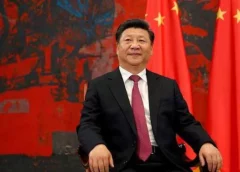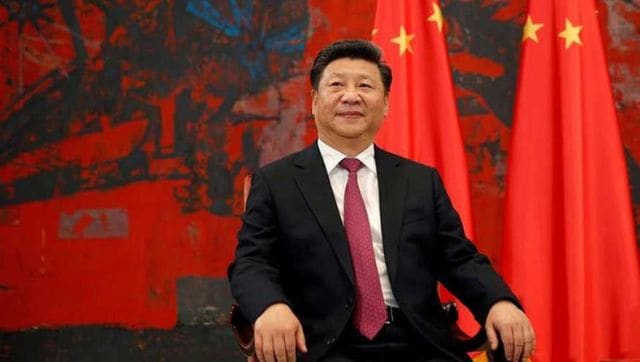
How Taiwan’s fate is closely linked with China’s internal political churn
[ad_1]
The situation will remain tense for a few months, at least till the domestic situation in China becomes clearer

Chinese president Xi Jinping. Image courtesy News18
In response to US House Speaker Nancy Pelosi’s visit to Taiwan on 3 August 2022, the Chinese military is conducting military operations from 4-6 August around Taiwan. Two Chinese aircraft carriers and warships are near, or in, the Taiwan Straits and fighter aircraft are regularly violating Taiwan’s air defence identification zone in batches of 15 or more aircraft. The question is: How does China expect this to play out? What might happen if PRC decides to militarily unify Taiwan? And does Xi Jinping have the political will to do it?

US House Speaker Nancy Pelosi, left, and Taiwanese President President Tsai Ing-wen. AP
Technically speaking, this is the fourth Taiwan Strait crisis; the first was in 1955 when China seized Yijiangshan Islands forcing Taiwan to abandon the Tachen Islands. The second was in 1958 when China shelled Kinmen and Matsu Islands but the US intervened. The third was in 1995-96 where massive Chinese military exercises were meant to signal China’s displeasure at the visit of Taiwanese President Lee Teng-hui to the United States.
So what’s different between 1995-96 and today?
On 18 July 1995, Beijing announced that missile tests would be conducted targeting an area some 90 miles off the coast of northern Taiwan, including DF-15 ballistic missiles. This time however the exercises are being held much closer. Of the six exercise areas announced by China, some actually protrude into Taiwan’s 24-nautical-mile adjacent area and territorial waters.
In 1995, after a five-day advance warning, Chinese naval vessels and aircraft conducted ten days of live-fire tests on the mainland coast opposite Taiwan. Further military exercises were conducted in mid-November to the south of the straits, including joint operations involving air, land, and forces. In 2022, however, reports state that Chinese Landing Craft in Fujian (the province facing Taiwan) are being loaded with military vehicles and tanks indicating preparations for an amphibious landing. More than 100 sorties of military aircraft have conducted combat training exercises such as joint reconnaissance, aerial refuelling, airspace control, and strikes on ground targets. Over 10 destroyers and frigates from the navy are conducting blockade operations in waters off the Taiwan Island. In short all three arms — amphibious land forces, air and sea — are being mobilised simultaneously.
***
Also Read
Taiwan is no walk-over and China knows it very well
From 1949 to 2022: A look back at the ups and downs of the China-Taiwan relationship
US-China relations on a precipice after House Speaker Nancy Pelosi’s visit to Taiwan
***
The intensity of the military drills this time has broken all previous records and the situation in the Taiwan Strait presently is extremely tense. Drawing parallels from the Russia-Ukraine war where exercises turned into actual combat, what if the Chinese decide to escalate the situation? An all-out integrated attack cannot be ruled out but this does not seem a viable option for China in the immediate future given the possibility of US and Japanese intervention. The great risk here is not Taiwanese resistance, but a war between the great powers.
This is precisely why a more likely scenario will be a long strangulation. With current forces China can blockade Taiwan, crippling its economy, which will ultimately lead to actual war should Taiwan choose to end the blockade. The second option is a limited military offensive by China to capture the outlying islands of Kinmen, Matsu and Taiping which are much closer to China than they are to Taiwan. Again, this would require a massive risk in assuming this will be allowed without interference from the US and Japanese navy. Either option would impose significant economic and psychological costs on Taiwanese citizens. In both scenarios, the Taiwanese government will have to use its military. While the balance of forces is overwhelmingly in China’s favour, this does not account for training, morale, and technological sophistication as well as Taiwan’s ability to execute asymmetric tactics.

If any of these scenarios eventuate, Taiwan will have little choice but to accede to a few Chinese demands in order to minimise the possibility of even a limited war.
The question still remains: Does Chinese President Xi have the political will? The domestic situation in China is not also as favourable to current Chinese establishment. Due to the removal of term limit for the apex posts in the Party, mishandling of Covid-19, and a depleting economy, President Xi Jinping faced criticism within the Party; several reputed Chinese citizens such as Profesor Xu Zhangrun of Tsinghua University had been blunt and direct in their criticism of the President and his policies. But President Xi has further extended his control and initiated a campaign to rekindle popular nationalism (including the study of Party history) to overcome his past setbacks. More than anything, such moves have made the fissures within the Party more obvious and Xi would not want an armed conflict by launching a military attack on Taiwan under such a precarious domestic scenario.
Conversely, if he perceives the domestic situation to be too precarious and believes he’s running out of options for diversion, he may very well choose military action. One needs to watch his actions prior to the 20th Party Congress or immediately after its conclusion in October 2022. A publicity-based image building exercise by Xi could indicate a reduced need for military action.
For now, the situation will remain tense for a few months, at least till the domestic situation in China becomes clearer.
The writer is Research Fellow, Centre for China Analysis and Strategy. Views are personal.
Read all the Latest News, Trending News, Cricket News, Bollywood News,
India News and Entertainment News here. Follow us on Facebook, Twitter and Instagram.
[ad_2]
Source link


